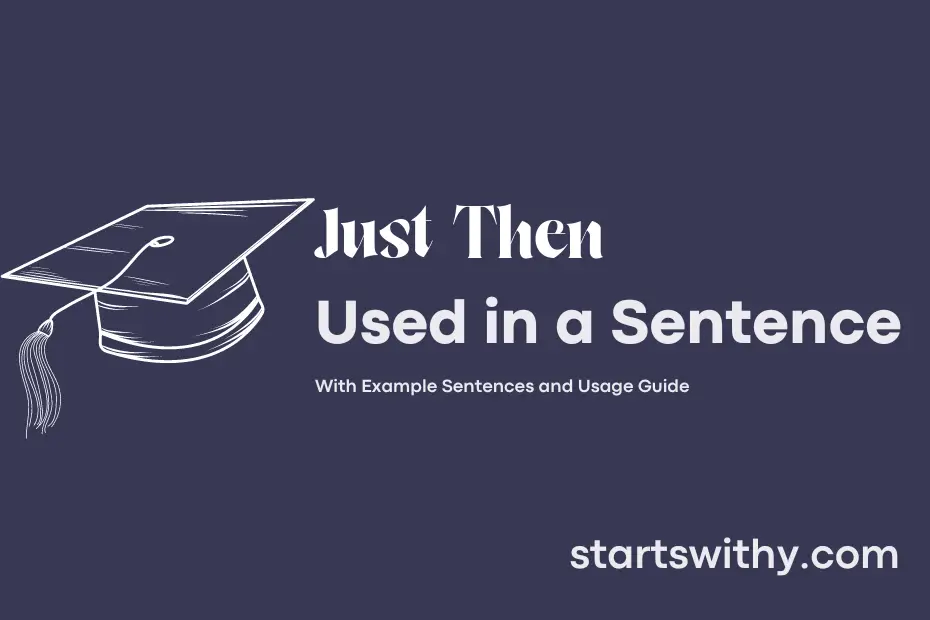Do you know how to properly use the phrase “just then” in your writing? This expression is commonly used to describe an action or event that occurred at a precise moment in the past.
When incorporating “just then” into your sentences, it signifies a specific timeframe, often indicating that something happened immediately or shortly before or after another action. This phrase helps create a sense of immediacy and flow in your writing.
7 Examples Of Just Then Used In a Sentence For Kids
- Just then, the bell rang for recess.
- I ran to catch the bus, but just then it started to rain.
- Just then, I heard a bird chirping outside my window.
- I was about to eat my lunch when just then a friend called me.
- Just then, the teacher entered the classroom with a big smile.
- I was looking for my toys when just then I found them under the bed.
- Just then, the sun came out from behind the clouds.
14 Sentences with Just Then Examples
- Just then, the professor entered the classroom to begin the lecture.
- Just then, the WiFi connection suddenly dropped in the middle of an online exam.
- Just then, a fellow student asked if anyone wanted to join a study group for the upcoming exam.
- Just then, the library announced that it would be closing in ten minutes.
- Just then, the canteen started serving freshly made dosas, much to everyone’s delight.
- Just then, the hostel warden reminded students about the curfew time for the night.
- Just then, a notice was put up about a guest lecture by a renowned industry expert.
- Just then, a group of friends decided to order some late-night snacks for their study session.
- Just then, the college sports team won a crucial match, leading to celebrations all around campus.
- Just then, the power went out, leaving the entire dormitory in darkness.
- Just then, a friend texted about a last-minute assignment that was due the next day.
- Just then, a student received a notification about a scholarship opportunity for a study abroad program.
- Just then, the department head announced the date for the upcoming college fest.
- Just then, the student council president walked in with information about volunteering opportunities for a social cause.
How To Use Just Then in Sentences?
Just Then can be used to indicate a sudden action or event that took place in the immediate past. It is used to create suspense or highlight the timing of a specific moment in a storyline.
Here’s an example sentence to illustrate the use of Just Then:
– “I was about to leave the house when just then the phone rang, and it was my long-lost friend calling.”
In this sentence, the phrase “Just Then” signals that the phone call from the friend occurred at the exact moment the speaker was about to leave, emphasizing the sudden interruption.
When using Just Then in a sentence:
– Place the phrase at the beginning or middle of the sentence to emphasize the immediacy of the action or event that took place.
– It is usually followed by a comma to separate it from the rest of the sentence.
– Use it to create a sense of surprise, suspense, or to highlight the suddenness of a situation.
Practice incorporating Just Then into your writing to add depth and immediacy to your storytelling. Experiment with different scenarios to see how this phrase can enhance the impact of a specific moment within your narrative.
Conclusion
In writing, using sentences with “just then” helps to indicate a specific moment or sequence of events in a clear and direct manner. It guides the reader through the timing of events and adds emphasis to the actions or emotions being described. By structuring sentences with “just then,” writers can create a dynamic narrative that keeps readers engaged and easily follows the flow of events.
These sentences provide a smooth transition between different actions, thoughts, or scenes, enhancing the coherence of the writing. By using “just then,” writers can effectively convey the progression of events and evoke a sense of immediacy and connection for the reader. Overall, incorporating sentences with “just then” can improve the structure and clarity of writing, making it more engaging and compelling for the audience.



